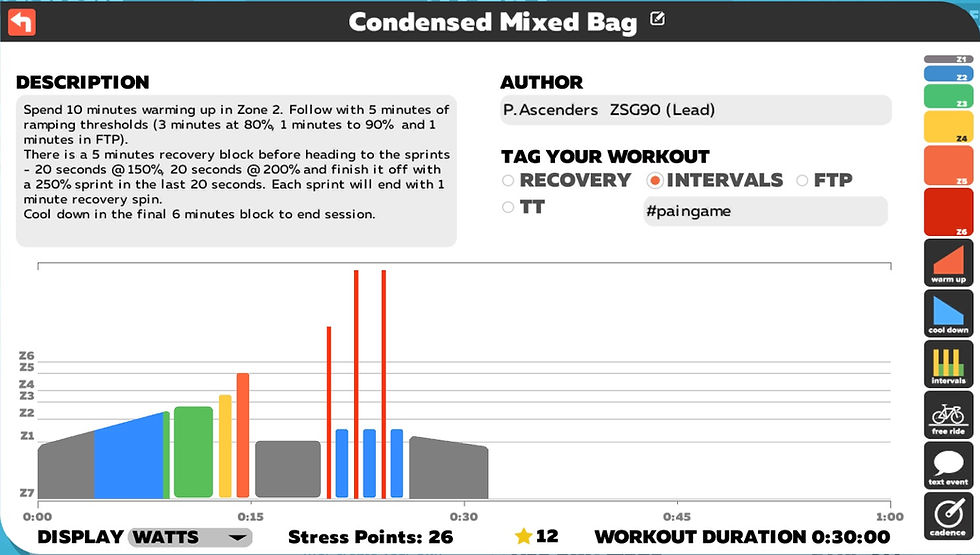MAGENE GRAVAT 2017 USER REVIEW
- The Taicho
- Oct 29, 2017
- 5 min read
MAGENE GRAVAT 2017 USER REVIEW
Introduction
Since the beginning of 2017, Magene has introduced a new SMART, direct-drive trainer named the “GRAVAT”.
This trainer first came to public view at the Taipei Bike Show 2017 in March. Magene started to take sales order for this trainer since April’17 for both China and Taiwan markets. However, it remained elusive outside these countries with exception of Thailand, which has an existing distribution channel.
Specifications
So what is the Gravat about and why should we get excited?

Here are some notable specifications about the Gravat from their website (www.magene.cn).
Maximum Wattage: 2,500 watts
Slope Simulation: 15%
Power accuracy: +-3%
Dimension: Unfolded - 600*518.5*453mm / Folded - 600*511.5*314mm
Wireless Interface: Bluetooth, ANT+& FE-C Supported, ERG enabled
Gross Weight: 13kg
Flywheel Weight: 5kg
Cassette: Shimano/SRAM freehub, 9-11 speed cassette.
Noise Level: 55 dB(@1.5m&30KPH)
Compatibility: 130mm, 135mm bicycle frame.
Magene states that it can hit a maximum high of 2,500 watts – hardly going to reach that. The Power accuracy is rated at within 3% which is typical for such a class of smart trainer. In a later section, this will be covered in an accuracy test.
Gravat comes with ANT+ and Bluetooth protocols, capable of FE-C functions. The typical climbs in ZWIFT seems well covered with its 15% gradient ability sans the steepest sections at 17% (telegraph climb) / 18% (Richmond cobbles).
First Impressions
Heard a knock on the door late one night and there stood a gentleman from the delivery company. Quote: “Sir, your order which is quite HEAVY is here”. Wow, huge carton box for a small trainer?

I believe the first ever GRAVAT has arrived in Singapore. Finally, after all the research and leap of faith into a relatively unheard of smart trainer, it has landed into my hands.
So it’s time to do an unboxing segment for the product.
Unboxing the Gravat
The GRAVAT’s accessories can easily go unnoticed. Here are the items found inside the carton besides the trainer itself:
1. Power Supply cord with China plug standard (adapter needed)
2. ANT+ USB Dongle by Magene
3. Rear Dropout Adapter with shim (Reversible 130mm / 135mm)
4. Double-sided tape padding (not magnet patches)
5. Cassette Spacer for 10 speeds.
6. Steel Skewers
7. USB 2.0 extension cable with for ANT+ dongle
8. Manuals and warranty card

Watch the video below for unboxing the Gravat smart trainer.
Set up
Once the trainer is out of the box, flip apart the orange T-stand at the pivot-point and position the trainer on the ground.
Install a cassette (in my case Ultegra 11-28T) and tighten the lockring. Mount the Axle adapter for either 130mm or 135mm which is dependent on the width of the frame dropouts. Firmly secure the Quick Release supplied and we are ready to calibrate the trainer.

Connect the power cables supplied to the trainer to fire it up. Cut the Zip tie securing the Flywheel unit during transportation prior to using the trainer.

With all the hardware preparation completed, it is time for us to mount up the bicycle for calibrations required.

Once you have switched on the power supply, the will be a series of red LED flashes followed by a few flashes of green before it becomes a permanent green light.
With the trainer all powered up, let’s go into the next section where we will perform the necessary calibration and setup for use.

Configuration and Calibration:
Magene has presented a mobile phone app for both Android and iOS platforms to be downloaded. Use your mobile phone QR Reader to download the appropriate app platform for GRAVAT calibrations and firmware update.






The GRAVAT is now ready for serious indoor cycling ahead!
Performance / Riding
When it comes to the feel for the equipment it’s going to be a very personal view about it. Basically on 0% gradients, steady states efforts are no issue for the Gravat as the wattages appear to be stable.
Once the gradients started to kick up on the map, Gravat will take a about anything under 2 seconds to adjust the resistance and match the percentages. I found this to be very evident in ZWIFT as the climbs set in or in segments like the S-Bends on Watopia where the gradient can vary throughout.

Not so spot on with FE-C? Not exactly but then again not immediate too which is acceptable to me. I have learnt to adjust myself in advance of gradient changes in ZWIFT when you can tell the tiny lag. As in typical well-built trainers, I found the build to be stable and well-planted to the ground. There is no shaky feeling and bouncing about when going for a hard sprint or out of saddle climbs.
The resistance feel applied to the trainer for gradient is pretty good while on OneLap, ZWIFT and RoadGrandTours. When I set the resistance to 100% difficulty, you can be sure its going to be a long day especially on climbs.
Click to watch the climb on Passo del Stelvio with the Gravat at 100% difficulty.
So how does ERG perform? I am glad to say I got into the specific power zones in my workouts pretty quickly and held there all the time.
The video clip will show that the Gravat gets in to the power regardless of the cadence I was churning out. If it is 180 watts, then its 180watts which is pretty much straightforward.
Accuracy Tests
Power accuracy is one of the main reasons why customers will buy a smart trainer for. With an existing Power2Max Type S at home, I assume this is a good platform to compare with the power data of the Gravat. Now what I needed is a workout plan to do the comparison.
So I whipped up my own “Condensed Mixed Bag” workout session that lasted 30 minutes – ramps, short thresholds, sprints etc. to simulate the highs and lows in a single session.

From the results of the database gathered from both powermeters, it appears that the charts for both devices are not very far off.

However, when overlaid together, the Power2Max has a much higher reading spike whenever I got into a start of a sprint which is normal for crank based powermeters.
Otherwise, both readings are hardly discernible from the graph illustration. Not exact but close enough when it mattered. The average power variance between both devices based on per second logging is 2.54%, well within the 3% power accuracy claimed by Magene.
Sound Check
So how quiet is the Gravat? We put it through the paces and gathered an average sound level of about 60 d/B which will hardly disturb anyone in the apartment. In fact, I can hear my drivetrain easily than the Gravat which is really nice.
Click the video clip to watch the actual sound test being conducted .
Conclusion
Well I felt that though this may not be the perfect smart trainer of all time but it certainly ranked high in terms of the features that I have covered. I will give it a 4.25/5 overall rating.
From my personal standpoint, it performs well despite the tiny lag encountered for adjusting to gradients. Riders who are using it for racing may need to make a minor adjustment to ensure you do not lose the plot when the road goes up/down. Hopefully Magene will come up with a firmware upgrade in future to make it even more precise.
For its competition, I felt it should be well-placed with other trainers like Tacx Flux, Elite Direto, Wahoo Kickr Snap, Cycleops Magnus and Minoura Kagura(?).



Comments